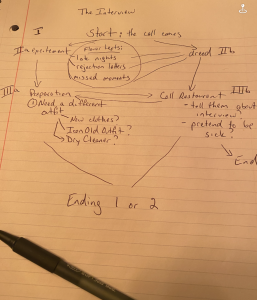Stories with Maps
The techniques and methods presented in this section will show you how to write with a sense of geography for your story, a “map.” It might be helpful to think of this map as taking the form of a tapestry, a woven image or pattern made of the intertwining of different threads. This is because Ink stories refer to their component parts using vocabulary such as weave and gather, thread and stitch and knot, of which we will go into more detail later. Before we begin, let’s unpack this concept of Ink stories as an intertwining of different threads. When you introduce a situation for the reader to select between two options, such as in Inky’s “Once Upon a Time…” sample story, you create two paths or threads. Each of those threads might separate into any number of new threads. Eventually, you may want to gather all the threads once again, weaving the narrative back together. In this text we will think about an Ink story as both a map and a tapestry.
The geography we refer to in the lessons in this section is conceptual. The map we mean is not necessarily the same as the imagined landscape your characters may be moving across (although they might be related if you would like them to be). In this case, the map shows the relationship or paths between units of text. We will refer to these units of texts with paths connecting them to other units of text as “nodes.” Perhaps a node relates to a place in your story, or a conversation with a specific character, or an important decision the reader has to make. A node on the story’s map might be a single sentence, or it could be dozens of pages of background material. The map, therefore, shows how the nodes are connected, how the threads are woven together to form a pattern in the tapestry.
For simple stories, like Inky’s sample story, you can keep track of the map in your head. Complicated narratives might require elaborate spreadsheets to keep track of all of the various threads and potential conditions. A great way to start visualising the fabric of your playable story is the old fashioned way—pen and paper.

As you work through the following lessons, keep these conceptual maps in mind. As you learn about the different units used when writing a story with Ink and Inky, think of how they relate to each other and how they can be organised in order to be of best use to your playable story.

